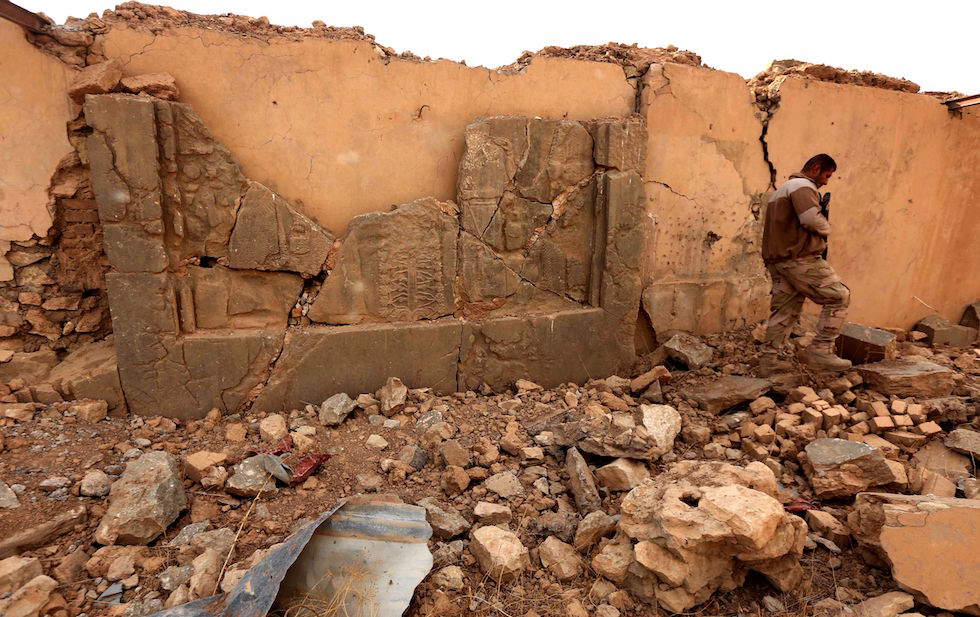Can artistic heritage be considered a victim of armed conflicts? According to Irina Bokova, director general of UNESCO from 2009 to 2017, the deliberate destruction of any form of artistic heritage is in effect a crime against humanity: this statement is very significant, because it is not a matter of putting stones before the suffering of men (as has often been uncritically and polemically done), but because it emphasizes the need to preserve the memory of places and testimonies of men of the past; not only stones, but precisely also people and memories, emotions and facts related to those very people, in a continuous balancing and exchange between collective and personal memories. In this regard, it seems interesting to me to report the testimony of a leader of a community in Nimrud (Iraq) who, when faced with the explosion that partially pulverized the remains of the ancient Assyrian palace, said that such devastation was to all intents and purposes comparable to the destruction of one’s own homes and the killing of loved ones, because Nimrud was and is perceived as a familiar place that has characterized that space and those places for centuries, thus being by now part of a stratification of memories and, we might add, of the DNA of the local populations.
 |
| Damage in Nimrud during the civil war (2016). Ph. SAFIN HAMED/AFP/Getty Images. |
How can these wounds be healed and sewn up? In the face of such events, one often feels powerless, not least because one is forced to run for cover when the worst has already happened: the disastrous and criminal looting of the Baghdad Archaeological Museum in 2003 is still vivid in everyone’s memory, especially Iraqis. Those wounds are still open and bleeding also because many objects were lost forever because they were destroyed or stolen and then resold to unscrupulous international collectors or museums. What can we do? Are we forced only to endure and contemplate our inability to prevent these tragedies? Actually, despite the difficulties of taking action during conflicts, it is possible to do something to preserve and keep intact those historical-artistic testimonies that deeply mark the daily lives of local populations: the commitment of people who have dedicated and, in some cases, even sacrificed their lives for the protection of the historical-artistic heritage of countries at war is well-known and commendable. However, praise is not enough: what is needed is the commitment of all, an international involvement under the legida of UNESCO so that the principles and values of the defense of all forms and types of historical-artistic heritage without discrimination and without classifications of importance are respected. There may certainly be cases that are more urgent than others, but this should not then lead to making choices that exclude the protection and recovery of other assets. LUNESCO, even within its limitations, is the only international organization capable of lobbying for protection during conflicts, on the one hand, and promoting the effective reconstruction and rehabilitation of sites, museums and natural areas, on the other.
There are two concrete actions that can, must, be tenaciously pursued by the international community: first of all, when conflicts are over, one must not let one’s guard down, especially with regard to investigative operations to recover illegally stolen assets that may reappear even 15 or 20 years after their disappearance, when the memory of the events is already distant; cooperation with local governments that would request the legitimate return of assets is essential and must respect the laws of international law. Finally, a very careful and monitored operation of reconstruction of the destroyed sites and monuments is necessary: the temptation to remove the rubble and proceed to a quick reconstruction can be strong and it is precisely here that the role of UNESCO, which must, however, also be concretely translated into the financial support of the superintendencies and directorates of antiquities of the affected countries, must become effective. Reconstructions can, dare I say they must, take place, but principles of congruence and preservation of the state of antiquities before their destruction and, why not, of their current condition after suffering damage, even irreparable damage, must be respected: preserving even the memory of destruction can be a useful tool of memory for future generations.
This contribution was originally published in No. 6 of our print magazine Finestre Sull’Arte on paper. Click here to subscribe.
Warning: the translation into English of the original Italian article was created using automatic tools. We undertake to review all articles, but we do not guarantee the total absence of inaccuracies in the translation due to the program. You can find the original by clicking on the ITA button. If you find any mistake,please contact us.